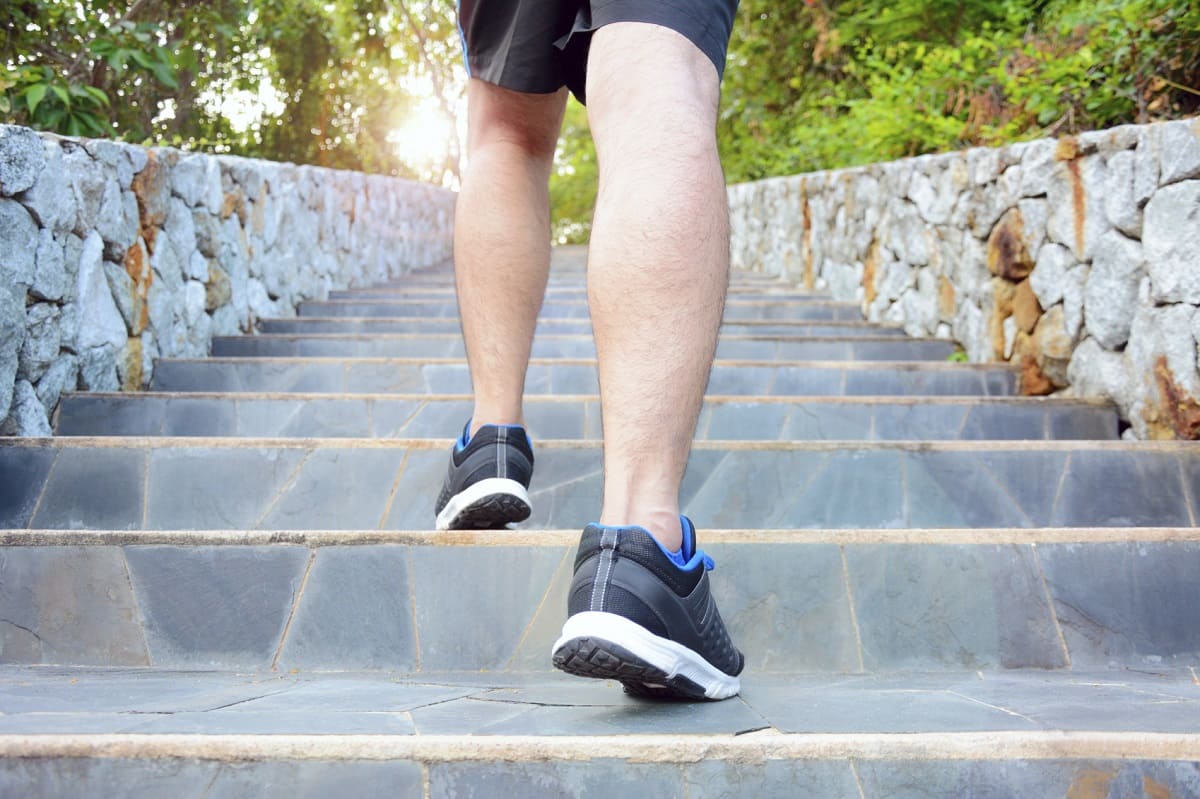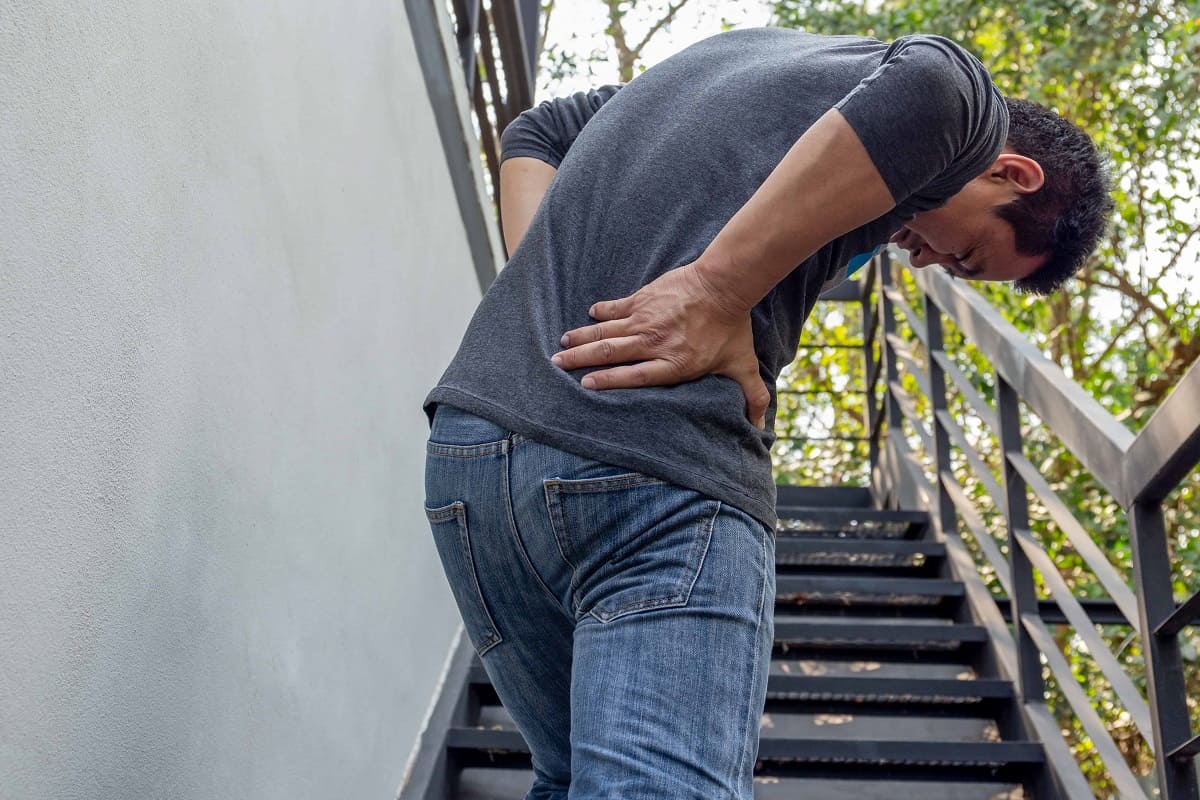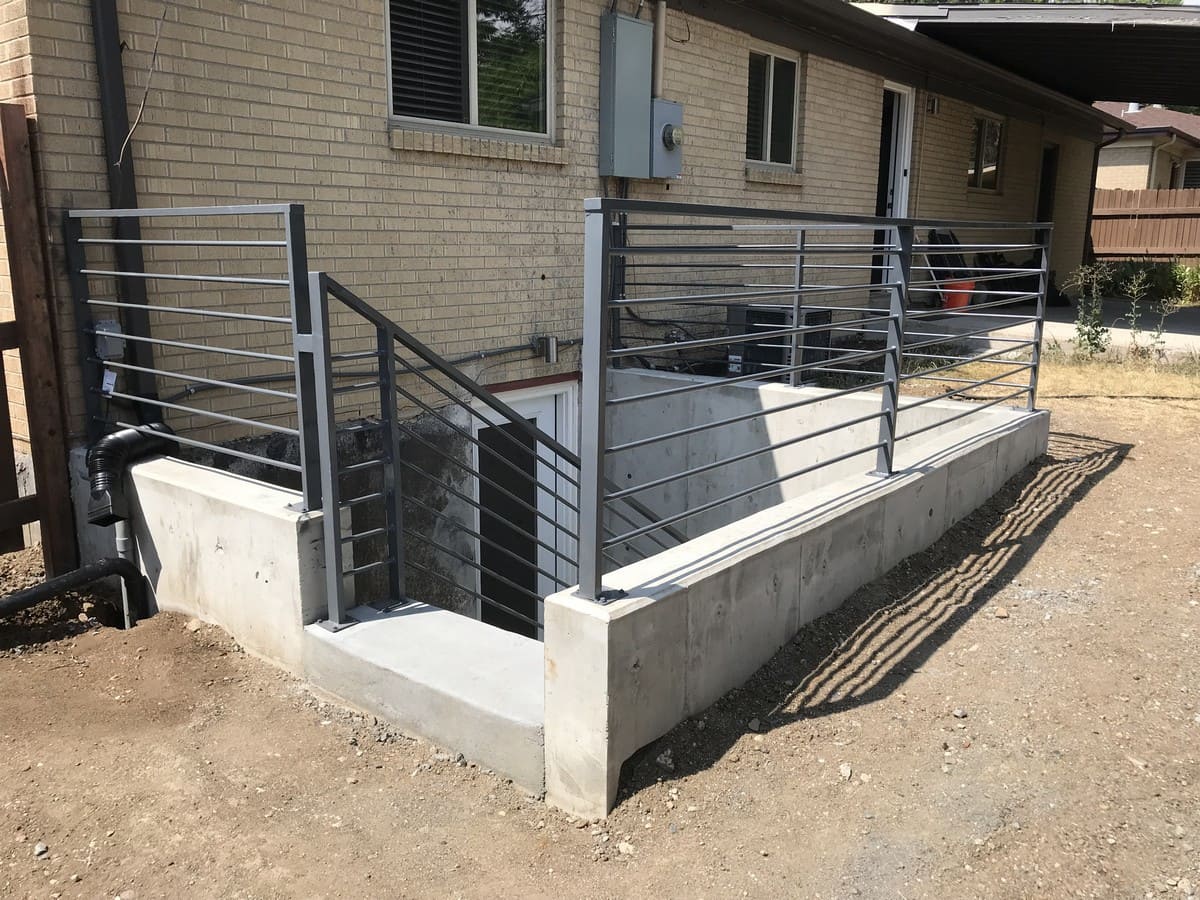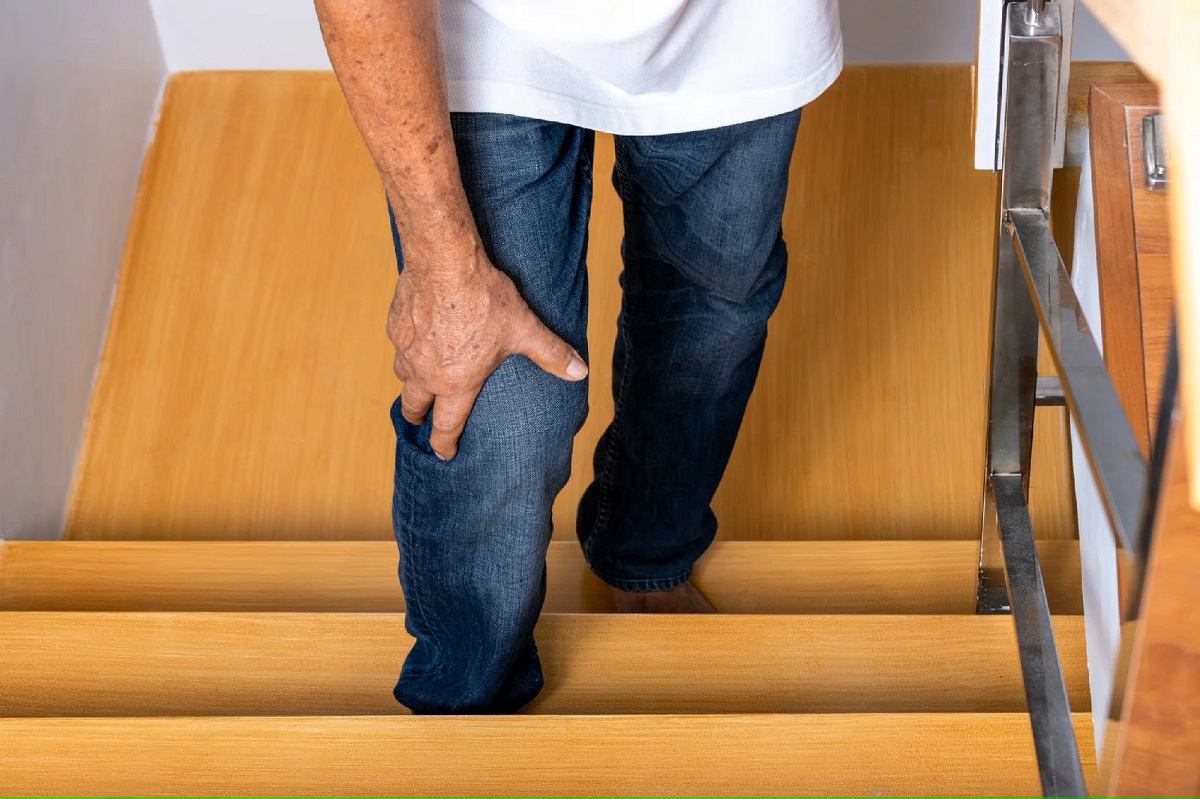

Articles
Out Of Breath When Walking Up Stairs
Modified: December 7, 2023
Improve your stamina and endurance with our informative articles on how to prevent becoming out of breath when walking up stairs.
(Many of the links in this article redirect to a specific reviewed product. Your purchase of these products through affiliate links helps to generate commission for Storables.com, at no extra cost. Learn more)
Introduction
Have you ever found yourself out of breath when walking up a flight of stairs? If so, you’re not alone. Many people experience this sensation, known as shortness of breath or dyspnea, during physical activity. While it’s normal to feel slightly winded after climbing stairs or engaging in vigorous exercise, persistent and severe breathlessness could indicate an underlying health issue.
Shortness of breath can be a cause for concern, as it may affect your daily activities, overall quality of life, and even indicate an underlying medical condition. In this article, we will explore the common causes of shortness of breath when walking up stairs and discuss possible treatment options to alleviate this symptom.
Before delving into the causes, it’s essential to understand what shortness of breath actually means. When you experience shortness of breath, you feel as though you are unable to get enough air into your lungs. This can manifest as rapid or shallow breathing, chest tightness, wheezing, or a feeling of suffocation. It’s important to distinguish between normal breathlessness during physical exertion and abnormal shortness of breath that occurs even with minimal effort or at rest.
There are various factors that can contribute to shortness of breath, including lack of exercise and poor fitness, obesity and excess weight, cardiovascular conditions, lung conditions, anemia and low iron levels, asthma and allergies, chronic obstructive pulmonary disease (COPD), and other possible causes. It’s crucial to understand the root cause of your breathlessness in order to receive appropriate treatment and manage the symptoms effectively.
If you frequently experience shortness of breath when walking up stairs or performing day-to-day activities, it may be a sign that something is amiss. It’s important not to ignore this symptom, as it may indicate an underlying health condition that requires medical attention. In the following sections, we will discuss in detail each potential cause of shortness of breath and provide information on when to seek medical help and available treatment options.
Remember, this article is meant to serve as a guide and does not replace professional medical advice. If you have concerns about your breathing or any other health issues, it is important to consult with a healthcare professional for an accurate diagnosis and appropriate treatment.
Key Takeaways:
- Shortness of breath when walking up stairs may indicate underlying health issues. Identifying the cause through a healthcare professional’s evaluation is crucial for effective management and improved respiratory health.
- Incorporating lifestyle changes, such as quitting smoking and staying physically active, can significantly improve breathing and alleviate shortness of breath. Consult with a healthcare professional for personalized treatment and support.
Read more: Dizzy When Walking Up Stairs
Understanding Shortness of Breath
Shortness of breath, also known as dyspnea, is a common symptom that can be caused by a variety of factors. It refers to the sensation of breathlessness or difficulty breathing, which can range from mild to severe. Understanding the underlying mechanisms of shortness of breath can help us grasp why it occurs and how it affects our bodies.
When we breathe, our lungs take in oxygen and expel carbon dioxide. During physical activity or exertion, our bodies require more oxygen to be supplied to the muscles. This increased demand prompts the respiratory system to work harder, resulting in a rapid and deeper breathing pattern. As a result, shortness of breath can be a natural response to increased physical demands.
However, if shortness of breath occurs during everyday activities, such as walking up stairs, it may indicate an underlying issue. Various factors can contribute to this symptom, ranging from lifestyle-related causes to medical conditions affecting the respiratory or cardiovascular systems.
Shortness of breath can be categorized into acute or chronic. Acute shortness of breath occurs suddenly and is often related to a specific event or condition, such as an asthma attack or anxiety. Chronic shortness of breath, on the other hand, persists over a longer period and may be indicative of an ongoing health condition.
It’s important to consider any accompanying symptoms when assessing shortness of breath. For example, if you experience chest pain, coughing, wheezing, or fatigue along with breathlessness, it could indicate a more serious condition that requires medical attention.
Understanding the causes of shortness of breath when walking up stairs can help you determine the underlying factors contributing to your breathlessness. In the following sections, we will explore some common causes, including lack of exercise and poor fitness, obesity and excess weight, cardiovascular conditions, lung conditions, anemia and low iron levels, asthma and allergies, chronic obstructive pulmonary disease (COPD), and other possible causes. By evaluating each potential cause, you can gain insight into your own situation and make informed decisions on seeking medical help and appropriate treatment options.
Remember, if you’re experiencing persistent or worsening shortness of breath, it’s important to consult a healthcare professional for an accurate diagnosis and tailored treatment plan. They can help determine the underlying cause and provide you with the necessary guidance and support to manage your symptoms effectively.
Common Causes of Shortness of Breath
Shortness of breath when walking up stairs can be attributed to several common causes, including lifestyle factors, medical conditions, and underlying physiological issues. Understanding these causes can help identify the contributing factors and guide appropriate treatment options. Here are some of the most prevalent causes of shortness of breath:
- Lack of exercise and poor fitness: A sedentary lifestyle and lack of regular physical activity can lead to decreased cardiovascular fitness and weakened respiratory muscles. This can result in breathlessness during even mild physical exertion.
- Obesity and excess weight: Carrying excess weight puts additional strain on the heart and lungs, making it harder to breathe during physical activity. The extra weight can impede proper lung function and restrict efficient oxygen exchange.
- Cardiovascular conditions: Congestive heart failure, coronary artery disease, and other heart conditions can impair the heart’s ability to pump blood efficiently. This reduces oxygen delivery to the body, leading to breathlessness and fatigue.
- Lung conditions: Chronic obstructive pulmonary disease (COPD), asthma, pneumonia, and other respiratory conditions can cause inflammation, narrowing of airways, or reduced lung capacity, resulting in difficulty breathing during physical exertion.
- Anemia and low iron levels: Anemia, a condition characterized by low levels of red blood cells or hemoglobin, reduces the oxygen-carrying capacity of the blood. This can lead to breathlessness due to inadequate oxygen supply to the body’s tissues.
- Asthma and allergies: People with asthma or allergies may experience shortness of breath triggered by allergens or irritants. Inflammation and constriction of the airways can occur, leading to difficulty breathing and wheezing.
- Chronic obstructive pulmonary disease (COPD): COPD is a progressive lung disease that includes chronic bronchitis and emphysema. It causes airway obstruction and destroys lung tissue, resulting in breathing difficulties during physical exertion.
- Other possible causes: Other factors that can contribute to shortness of breath include anxiety and panic disorders, deconditioning after a period of inactivity, smoking, exposure to environmental pollutants, and certain medications.
If you are experiencing shortness of breath when walking up stairs, it’s crucial to consult with a healthcare professional for a comprehensive evaluation. They can help identify the specific cause of your breathlessness through a physical examination, medical history review, and diagnostic tests if necessary.
Remember, successful management of shortness of breath relies on accurate diagnosis and appropriate treatment. By addressing the underlying causes and adopting lifestyle modifications, such as regular exercise, weight management, and medication management, you can alleviate your symptoms and improve your overall respiratory health.
Lack of Exercise and Poor Fitness
One of the common causes of shortness of breath when walking up stairs is a lack of exercise and poor fitness. Regular physical activity plays a crucial role in maintaining cardiovascular health and strengthening the respiratory muscles. When you lead a sedentary lifestyle and do not engage in regular exercise, your overall fitness level declines, and your body becomes less efficient at utilizing oxygen.
Physical fitness is closely tied to efficient oxygen delivery to the muscles and organs. When you exercise regularly, your heart and lungs become stronger, allowing for improved oxygen uptake and delivery throughout the body. This means that during activities like climbing stairs, your body is better equipped to meet the increased demand for oxygen, reducing the likelihood of experiencing breathlessness.
On the other hand, a lack of exercise and poor fitness can lead to a decrease in lung capacity and weakened respiratory muscles. This results in an inadequate exchange of oxygen and carbon dioxide, making it harder for your body to get the oxygen it needs and eliminate waste products.
When your body encounters physical exertion, such as climbing stairs, it requires more oxygen and expels more carbon dioxide. Without a baseline level of fitness, your body struggles to meet these demands, leading to a sensation of breathlessness.
Additionally, lack of exercise often accompanies other unhealthy lifestyle choices, such as poor nutrition and smoking. These factors can further contribute to reduced lung function and respiratory health, exacerbating the shortness of breath experienced when walking up stairs.
If you regularly experience shortness of breath during physical activity, it may indicate that your cardiovascular fitness level is inadequate. The good news is that with appropriate lifestyle changes, you can improve your fitness level and reduce breathlessness when climbing stairs or engaging in other activities.
To address this issue, consider incorporating regular exercise into your daily routine. Start with low-impact activities, such as brisk walking or cycling, and gradually increase the intensity and duration over time. Aim for at least 150 minutes of moderate-intensity aerobic exercise per week, as recommended by health guidelines.
In addition to aerobic exercise, incorporating strength training exercises can help strengthen your respiratory muscles, making it easier for your body to meet the demand for oxygen during physical activities. Focus on exercises that target your core and upper body, such as push-ups, planks, and dumbbell exercises.
Remember to consult with a healthcare professional or fitness expert before starting any new exercise regimen, especially if you have underlying health conditions or concerns about your physical capabilities.
Committing to regular exercise and improving your fitness level can help alleviate shortness of breath, increase your overall endurance, and enhance your quality of life. By making exercise a priority, you’ll not only improve your respiratory health but also experience numerous other benefits for your physical and mental well-being.
Obesity and Excess Weight
Obesity and excess weight are significant contributors to shortness of breath when walking up stairs. Carrying excess body weight puts additional strain on your cardiovascular system, making it harder for your body to meet the increased demand for oxygen during physical activity.
Excess weight affects your respiratory system in several ways. First, it can lead to a reduced lung capacity and restricted chest expansion, making it more difficult to take deep breaths. This limitation in lung function can result in a sensation of breathlessness even during simple tasks like climbing stairs.
Furthermore, excess weight can lead to an increased deposition of fat around the chest and abdomen. This extra fat can compress the lungs and diaphragm, impeding their ability to fully expand and contract. As a result, the amount of air you can inhale is reduced, leading to a feeling of breathlessness.
In addition, obesity is often associated with a higher prevalence of other health conditions, such as high blood pressure, type 2 diabetes, and cardiovascular disease. These conditions can further impair lung and heart function, exacerbating breathlessness during physical activity.
To address shortness of breath caused by obesity and excess weight, it is essential to focus on weight management and overall health improvement.
Start by implementing a well-balanced diet that consists of nutrient-rich foods and appropriate portion sizes. Incorporate plenty of fruits, vegetables, whole grains, lean proteins, and healthy fats into your meals. Avoid excessive intake of processed foods, sugary beverages, and foods high in saturated fats and added sugars.
In conjunction with a healthy diet, engage in regular physical activity to aid in weight loss and improve cardiovascular fitness. Choose exercises that are low impact and suitable for your current fitness level, such as walking, swimming, or cycling. Gradually increase the duration and intensity of your workouts as your fitness level improves.
Seeking support from healthcare professionals or weight management programs can provide valuable guidance and accountability on your weight loss journey. They can help you set realistic goals, monitor your progress, and provide personalized recommendations based on your specific needs.
Remember that sustainable weight loss takes time and requires a combination of dietary changes and regular exercise. Aim for gradual weight loss of 1-2 pounds per week, as rapid weight loss can be detrimental to your health.
By gradually reducing excess weight through lifestyle modifications, you can alleviate the strain on your cardiovascular system and improve your body’s ability to supply adequate oxygen during physical activity. As a result, you will experience reduced breathlessness when climbing stairs and other exertional tasks.
Always consult with a healthcare professional before making any major changes to your diet or exercise routine, especially if you have underlying health conditions or concerns about your physical capabilities.
Remember that a holistic approach to weight management, incorporating healthy eating habits and regular physical activity, is key to not only reducing shortness of breath but also improving your overall well-being.
Read more: Knees Crack When Walking Up Stairs
Cardiovascular Conditions
Cardiovascular conditions can significantly contribute to shortness of breath when walking up stairs. These conditions affect the heart’s ability to pump blood efficiently, leading to reduced oxygen delivery to the body’s tissues and organs. As a result, individuals may experience breathlessness during physical activity or even at rest.
There are several cardiovascular conditions that can lead to shortness of breath:
- Congestive heart failure (CHF): CHF occurs when the heart is unable to pump blood effectively, causing fluid to accumulate in the lungs and other organs. This fluid buildup, known as pulmonary congestion, leads to difficulty breathing, specifically during exertion.
- Coronary artery disease (CAD): CAD is characterized by the narrowing or blockage of the coronary arteries, which supply blood and oxygen to the heart muscle. When these arteries become restricted, the heart may not receive enough oxygen-rich blood during physical activity, resulting in shortness of breath.
- Heart valve disorders: Conditions such as aortic stenosis or mitral valve regurgitation can impair the normal functioning of the heart valves. As a result, the heart may struggle to pump blood efficiently, leading to reduced oxygen delivery and breathlessness during exertion.
- Arrhythmias: Certain abnormal heart rhythms, such as atrial fibrillation or ventricular tachycardia, can disrupt the heart’s pumping action. This irregular pumping can result in inadequate blood flow and oxygen supply, causing shortness of breath when the heart is under stress.
Individuals with known cardiovascular conditions or risk factors, such as high blood pressure, high cholesterol, obesity, or a family history of heart disease, are at a higher risk of experiencing shortness of breath during physical activity.
If you suspect that a cardiovascular condition may be causing your breathlessness, it is crucial to seek medical attention. A healthcare professional can evaluate your symptoms, perform diagnostic tests, and develop a treatment plan tailored to addressing the specific underlying condition.
Treatment options for cardiovascular conditions may include lifestyle modifications, such as adopting a heart-healthy diet, engaging in regular physical activity, quitting smoking, and managing stress. Medications, such as beta-blockers or ACE inhibitors, may be prescribed to improve heart function and manage symptoms like shortness of breath.
In more severe cases, medical procedures or surgery, such as coronary artery bypass grafting or valve replacement, may be necessary to alleviate symptoms and improve overall cardiovascular health.
It’s important to remember that cardiovascular conditions require ongoing management and monitoring. Regular follow-ups with your healthcare provider and adherence to prescribed treatments are vital for effectively managing symptoms, preventing complications, and improving your overall quality of life.
If you experience sudden and severe shortness of breath, chest pain, or any other symptoms of a heart attack, seek immediate emergency medical attention.
Lung Conditions
Lung conditions can play a significant role in causing shortness of breath when walking up stairs. These conditions affect the structure and function of the lungs, leading to impaired airflow, reduced oxygen exchange, and increased breathlessness during physical activity.
Here are some lung conditions that can contribute to shortness of breath:
- Chronic Obstructive Pulmonary Disease (COPD): COPD is a progressive lung disease that encompasses chronic bronchitis and emphysema. It is characterized by inflammation and obstruction of the airways, making it difficult to breathe. As a result, individuals with COPD may experience significant breathlessness during activities like climbing stairs.
- Asthma: Asthma is a chronic condition characterized by inflammation and narrowing of the airways. When triggered by certain substances or allergens, the airways become constricted, making it challenging to move air in and out of the lungs. This can lead to wheezing, coughing, and shortness of breath.
- Pneumonia: Pneumonia is an infection that causes inflammation and fluid buildup in the lungs. The infection leads to reduced lung function, compromising the exchange of oxygen and carbon dioxide. As a result, individuals with pneumonia may experience breathlessness and fatigue, especially during physical activities like climbing stairs.
- Pulmonary fibrosis: Pulmonary fibrosis is a condition characterized by the formation of scar tissue in the lungs. The scarring causes the lung tissue to become stiff and less elastic, making it difficult for the lungs to expand and contract efficiently. This can result in breathlessness, particularly during exertion.
- Lung cancer: Lung cancer can obstruct the airways and compromise lung function, leading to symptoms such as shortness of breath, persistent coughing, and chest pain. The presence of a tumor can restrict airflow and oxygen exchange, causing breathlessness during physical activities.
If you suspect that a lung condition may be causing your shortness of breath, it is imperative to seek medical attention. A healthcare professional can evaluate your symptoms, perform diagnostic tests, such as lung function tests and imaging studies, and determine the underlying cause of your breathlessness.
Treatment options for lung conditions will depend on the specific diagnosis. They may include medications to manage symptoms and reduce inflammation, pulmonary rehabilitation programs to improve lung function and breathing techniques, oxygen therapy, and in severe cases, surgical interventions.
In addition to medical treatments, making certain lifestyle adjustments can help alleviate shortness of breath. These adjustments may include avoiding respiratory irritants, such as smoke and environmental pollutants, practicing good respiratory hygiene, managing allergies, and maintaining a healthy weight.
Participating in pulmonary rehabilitation programs can provide education, exercise training, and support for individuals with lung conditions. These programs can help individuals improve their breathing techniques, increase physical endurance, and manage their symptoms more effectively.
Remember that lung conditions require ongoing management and monitoring. Regular follow-ups with your healthcare provider, adherence to prescribed treatments, and making healthy lifestyle choices are crucial for managing symptoms, slowing disease progression, and enhancing overall respiratory health.
Anemia and Low Iron Levels
Anemia, a condition characterized by a deficiency of red blood cells or hemoglobin, can contribute to shortness of breath when walking up stairs. Hemoglobin is responsible for carrying oxygen from the lungs to the body’s tissues, and a low level of hemoglobin means reduced oxygen-carrying capacity.
Low iron levels are a common cause of anemia. Iron is an essential mineral needed for the production of hemoglobin in red blood cells. When the body lacks sufficient iron, it cannot produce an adequate number of red blood cells or maintain normal hemoglobin levels. As a result, the body receives less oxygen, which can lead to breathlessness.
Shortness of breath due to anemia may occur with minimal exertion or during activities that would not typically cause breathlessness. Climbing stairs, which requires the body to work harder and demand more oxygen, can trigger noticeable breathlessness in individuals with anemia.
In addition to shortness of breath, other symptoms of anemia may include fatigue, weakness, pale skin, dizziness, and rapid heartbeat. If you suspect that anemia may be causing your breathlessness, it is important to consult with a healthcare professional.
A simple blood test can determine if you have anemia or low iron levels. If diagnosed with anemia, treatment options may include iron supplementation, dietary changes to incorporate iron-rich foods (such as lean meats, legumes, leafy greens, and fortified cereals), and addressing the underlying cause of the anemia.
It’s important to note that self-diagnosing anemia or attempting to treat it without medical guidance can be ineffective or potentially harmful. Different types of anemia require specific approaches, and some causes of anemia may require further investigation or intervention.
In some cases, anemia may be a symptom of an underlying health condition or chronic illness. It is essential to work with a healthcare professional to identify and address the root cause of the anemia to effectively manage the symptoms.
By addressing low iron levels and managing anemia, you can improve your body’s ability to transport oxygen, reducing breathlessness and improving your overall energy levels. Regular follow-ups with your healthcare provider and compliance with prescribed treatments are crucial for effectively managing anemia and ensuring optimal respiratory function.
Asthma and Allergies
Asthma and allergies are common causes of shortness of breath when walking up stairs. Both conditions affect the airways and can trigger episodes of breathlessness, especially during physical exertion or exposure to specific allergens.
Asthma is a chronic respiratory condition characterized by inflammation and narrowing of the airways. When individuals with asthma come into contact with triggers such as pollen, dust mites, pet dander, or cold air, their airways become inflamed and constricted. This can lead to symptoms such as wheezing, coughing, chest tightness, and shortness of breath, commonly known as an asthma attack.
Allergies, on the other hand, can cause similar symptoms due to an immune system response to specific allergens. When allergens, such as pollen, mold, or animal dander, are inhaled, the body releases histamines, leading to nasal congestion, sneezing, itchy eyes, and inflammation of the airways. This can result in breathlessness and difficulty breathing, particularly during physical activity.
Shortness of breath in individuals with asthma or allergies may be triggered by a combination of factors. When climbing stairs or engaging in exercise, the increased demand for oxygen and the body’s heightened respiratory rate can exacerbate airway inflammation and constriction, leading to breathlessness.
Proper management of asthma and allergies is crucial for reducing breathlessness and improving overall respiratory health. Treatment options for asthma and allergies may include:
- Medications: Inhalers, bronchodilators, and anti-inflammatory medications, such as corticosteroids, can be utilized to relieve symptoms and manage inflammation.
- Allergen avoidance: Identifying and avoiding triggers or allergens that exacerbate symptoms can help prevent episodes of breathlessness. This may involve measures such as using dust mite covers on bedding, minimizing exposure to pet dander, and staying indoors during allergy seasons.
- Allergy immunotherapy: In some cases, allergy shots or sublingual immunotherapy may be recommended to help desensitize the immune system to specific allergens and reduce the frequency and severity of symptoms.
- Education and self-management: Learning proper breathing techniques, monitoring symptoms, and developing an asthma or allergy action plan can empower individuals to take control of their condition and respond effectively when experiencing breathlessness or other symptoms.
If you suspect that asthma or allergies may be causing your shortness of breath when climbing stairs, it is important to consult with a healthcare professional. They can provide an accurate diagnosis, help identify triggers, and develop an individualized treatment plan to manage your symptoms effectively.
Remember to always carry your prescribed medications, such as inhalers or epinephrine auto-injectors, with you, especially during physical activities or when exposed to potential triggers.
With proper management and prompt treatment, individuals with asthma or allergies can lead active lives and minimize the impact of breathlessness on their daily activities.
Read more: How To Walk Up Stairs
Chronic Obstructive Pulmonary Disease (COPD)
Chronic Obstructive Pulmonary Disease (COPD) is a progressive lung disease that can cause significant shortness of breath when walking up stairs. COPD encompasses conditions such as chronic bronchitis and emphysema, which are characterized by airflow limitation and breathing difficulties.
In COPD, the airways become inflamed and narrowed, resulting in reduced airflow in and out of the lungs. Additionally, the destruction of lung tissue and the loss of elasticity make it harder for the lungs to expand and contract effectively, leading to breathlessness.
Shortness of breath is a hallmark symptom of COPD and is often more noticeable during physical activities, including climbing stairs. As the body requires more oxygen during exertion, the limited airflow and impaired lung function in individuals with COPD can make it challenging to meet the increased demand for oxygen.
Common risk factors for COPD include long-term exposure to lung irritants, such as cigarette smoke, air pollution, and certain occupational dust and chemicals. Genetics and a history of respiratory infections may also contribute to the development of COPD.
If you suspect that you may have COPD, it is crucial to consult with a healthcare professional. They can evaluate your symptoms, perform diagnostic tests such as spirometry, and determine the severity of the condition.
While COPD is a chronic condition that cannot be completely cured, proper management can significantly improve symptoms and quality of life. Treatment options may include:
- Medications: Inhalers and oral medications can help relax airway muscles, reduce inflammation, and improve breathing. Bronchodilators, corticosteroids, and combination therapies are commonly prescribed.
- Pulmonary rehabilitation: Pulmonary rehabilitation programs combine exercise, education, and support to help individuals with COPD manage their symptoms, improve lung function, and enhance their overall well-being.
- Oxygen therapy: Supplemental oxygen may be prescribed for individuals with low blood oxygen levels. Oxygen therapy can alleviate breathlessness and improve exercise tolerance.
- Surgery: In advanced stages of COPD, surgical interventions, such as lung volume reduction surgery or lung transplantation, may be considered to improve lung function and relieve symptoms.
- Lifestyle modifications: Avoiding lung irritants, such as smoking and exposure to secondhand smoke, as well as maintaining a healthy lifestyle with regular exercise and a nutritious diet, can help manage symptoms and slow disease progression.
It is important to work closely with your healthcare team to develop an individualized COPD management plan. Regular follow-ups, compliance with prescribed medications, and lifestyle modifications are essential for successful management and to minimize the impact of breathlessness on your daily activities.
Remember that early diagnosis and proactive management can greatly improve your quality of life, allowing you to engage in activities, including climbing stairs, with less breathlessness and more confidence.
Other Possible Causes
In addition to the common causes mentioned earlier, there are several other factors that can contribute to shortness of breath when walking up stairs. These causes can be related to various health conditions or lifestyle factors. Understanding these potential factors can help identify the underlying causes of your breathlessness.
- Anxiety and panic disorders: Anxiety and panic disorders can trigger shortness of breath, even during non-strenuous activities. The body’s stress response can lead to rapid breathing, shallow breaths, and a feeling of breathlessness.
- Deconditioning after a period of inactivity: If you’ve been inactive for a significant period, such as after an illness or prolonged bed rest, your body may have deconditioned. Weakened muscles and reduced cardiovascular fitness can contribute to breathlessness during physical activities like climbing stairs.
- Smoking: Smoking damages the lungs, reduces lung function, and increases the risk of developing respiratory conditions. Shortness of breath can occur due to the cumulative effects of smoking on lung health.
- Exposure to environmental pollutants: Chronic exposure to pollutants like smog, chemicals, and industrial fumes can irritate the airways and lead to respiratory symptoms, including breathlessness when exerting yourself.
- Medications: Some medications, such as beta-blockers, can cause shortness of breath as a side effect. If you’ve recently started a new medication and noticed a change in your breathing pattern, consult your healthcare professional.
- Underlying health conditions: Various health conditions, such as anemia, thyroid disorders, lung infections, or certain autoimmune diseases, can contribute to shortness of breath. It’s important to consider a comprehensive medical evaluation to identify any potential underlying conditions.
Each individual is unique, and factors contributing to shortness of breath can vary. It’s crucial to consult with a healthcare professional to evaluate your specific situation and determine the underlying causes of your breathlessness when climbing stairs.
If you are experiencing persistent or worsening shortness of breath, it is recommended to seek medical attention. A healthcare professional can conduct a thorough examination, order necessary tests, and develop a personalized treatment plan based on your specific needs.
By identifying and addressing the underlying causes, you can effectively manage your breathlessness and improve your ability to engage in physical activities without experiencing undue discomfort.
Remember that self-diagnosis can be unreliable, and professional medical guidance is essential for accurate diagnosis and appropriate treatment.
When to Seek Medical Help
Shortness of breath when walking up stairs can be a normal response to physical exertion, but in some cases, it may indicate an underlying health concern. It’s important to pay attention to the frequency, severity, and duration of your breathlessness, as well as any associated symptoms. Here are some guidelines on when to seek medical help:
- Sudden onset or worsening breathlessness: If you suddenly experience severe shortness of breath that is new or rapidly worsening, it may be a sign of a medical emergency and requires immediate medical attention.
- Persistent breathlessness: If you consistently experience breathlessness during minimal exertion, such as walking short distances or climbing a few steps, and it does not improve with rest, it’s important to consult with a healthcare professional.
- Accompanying symptoms: If your breathlessness is accompanied by symptoms such as chest pain, rapid heartbeat, dizziness, lightheadedness, coughing up blood, or swelling in the feet and ankles, seek medical attention promptly.
- History of respiratory or cardiovascular conditions: If you have a history of respiratory or cardiovascular conditions, such as asthma, COPD, heart disease, or pulmonary hypertension, it’s important to monitor your symptoms closely and seek medical help if there are any changes or worsening in your breathlessness.
- Concerns about your overall health: If your breathlessness is causing significant distress, affecting your daily activities, or if you have concerns about your overall health, it’s advisable to consult with a healthcare professional for a thorough evaluation.
Remember, everyone’s situation is unique, and these guidelines are general recommendations. If you’re unsure about the severity or cause of your breathlessness, it’s always better to err on the side of caution and consult with a healthcare professional for a proper assessment.
A healthcare professional will conduct a comprehensive evaluation, which may include a physical examination, medical history review, and possibly diagnostic tests, to determine the underlying cause of your breathlessness. They will then develop an appropriate treatment plan based on the findings.
Early intervention and proper management can help alleviate symptoms, improve your respiratory health, and enhance your overall well-being. Do not hesitate to seek medical help if you have concerns about your breathlessness or any other health issues. Your healthcare provider is best equipped to provide the guidance and care you need.
Diagnosis and Treatment Options
When experiencing shortness of breath when walking up stairs, seeking a proper diagnosis is essential for effective management and treatment. A healthcare professional will conduct a thorough evaluation to identify the underlying cause of your breathlessness. Based on the diagnosis, appropriate treatment options can be explored. Here’s an overview of the diagnosis process and potential treatment options:
Diagnosis:
The diagnosis of shortness of breath may involve several steps, which could include:
- Medical history: Your healthcare professional will review your medical history, including any pre-existing health conditions, medications you’re currently taking, and any family history of respiratory or cardiovascular diseases.
- Physical examination: A comprehensive physical examination will be conducted to assess your overall health. This may involve listening to your lungs with a stethoscope, checking your heart rate and rhythm, and evaluating your breathing pattern.
- Diagnostic tests: Depending on your symptoms and medical history, your healthcare professional may order additional tests. These may include pulmonary function tests, chest X-rays, electrocardiogram (ECG), blood tests, or other imaging studies to evaluate lung and heart function.
- Referral to specialists: In some cases, your healthcare provider may refer you to a specialist, such as a pulmonologist or cardiologist, for further evaluation or to perform additional diagnostic procedures.
Treatment Options:
The treatment options for shortness of breath will depend on the underlying cause identified through the diagnostic process. Here are some potential treatment options:
- Lifestyle modifications: Making certain lifestyle changes can help alleviate breathlessness. This may include maintaining a healthy weight, engaging in regular physical activity, quitting smoking, avoiding triggers, and practicing proper breathing techniques.
- Medications: Depending on the diagnosis, medications may be prescribed to manage symptoms, reduce inflammation, or improve lung function. These may include bronchodilators, corticosteroids, antibiotics for respiratory infections, or medications to treat underlying conditions.
- Pulmonary rehabilitation: Pulmonary rehabilitation programs combine exercise, education, and breathing techniques to improve lung function, increase exercise tolerance, and enhance overall respiratory health.
- Oxygen therapy: For individuals with low blood oxygen levels, supplemental oxygen therapy may be prescribed to increase oxygen levels and alleviate breathlessness.
- Surgical interventions: In some cases, surgical procedures, such as lung volume reduction surgery or lung transplantation, may be considered for individuals with advanced lung disease.
- Treatment of underlying conditions: If an underlying health condition is identified, such as anemia, asthma, or heart disease, treating and managing that condition will play a crucial role in relieving breathlessness.
It’s important to note that the treatment plan will be individualized based on your specific diagnosis and circumstances. Your healthcare professional will work closely with you to develop a tailored treatment approach to address the underlying cause of your shortness of breath.
Regular follow-up appointments with your healthcare provider are crucial for monitoring your progress, adjusting treatment as needed, and addressing any concerns or new symptoms that may arise.
Remember that successful management of shortness of breath requires a multifaceted approach, including lifestyle modifications, medication compliance, and active engagement with your healthcare provider. By actively participating in your treatment plan, you can effectively manage your symptoms and improve your overall respiratory health.
Regular cardiovascular exercise, such as walking, swimming, or cycling, can improve your stamina and make it easier to climb stairs without feeling out of breath. Start with small increments and gradually increase intensity.
Lifestyle Changes to Improve Breathing
Alongside medical treatment, making certain lifestyle changes can significantly improve your breathing and help manage shortness of breath when walking up stairs. These changes mainly focus on promoting overall respiratory health and optimizing lung function. Consider implementing the following lifestyle modifications:
1. Quit Smoking:
If you’re a smoker, quitting is one of the most impactful changes you can make for your respiratory health. Smoking damages the airways and decreases lung function. Seek support from healthcare professionals, smoking cessation programs, or support groups to help you quit for good.
Read more: How To Walk Up Stairs With A Cane
2. Maintain a Healthy Weight:
For individuals who are overweight or obese, losing weight can significantly improve breathing. Excess weight puts strain on the lungs and heart, making it harder to breathe during physical activities. Adopting a well-balanced diet and incorporating regular exercise can help achieve and maintain a healthy weight.
3. Stay Physically Active:
Regular exercise helps improve cardiovascular fitness and lung function. Engaging in activities such as walking, swimming, or cycling can enhance the efficiency of your respiratory system and increase your endurance over time. Start with activities of low to moderate intensity and gradually increase as your fitness improves.
4. Practice Breathing Techniques:
Proper breathing techniques can help improve lung capacity and control breathlessness. Techniques such as pursed-lip breathing and diaphragmatic breathing can promote better oxygen intake and reduce the feeling of breathlessness. Consider working with a respiratory therapist or attending pulmonary rehabilitation programs to learn these techniques.
5. Minimize Environmental Exposure:
Avoiding exposure to environmental pollutants, such as secondhand smoke, industrial fumes, and dust, is crucial for maintaining respiratory health. If you have allergies, use allergen-proof bedding, keep windows closed during high pollen seasons, and minimize exposure to known triggers.
Read more: Top Of Foot Pain When Walking Down Stairs
6. Manage Stress:
Stress and anxiety can worsen breathlessness and make it harder to breathe. Practice stress management techniques such as deep breathing exercises, meditation, yoga, or engaging in hobbies you enjoy to help reduce stress levels and promote relaxation.
7. Stay Hydrated:
Drinking an adequate amount of water helps thin mucus and keeps airways moist, facilitating easier breathing. Stay hydrated throughout the day by regularly drinking water or other non-caffeinated, non-alcoholic beverages.
8. Get Adequate Rest:
Ensure you’re getting enough sleep and rest to allow your body to recover and rejuvenate. Fatigue can exacerbate breathlessness, so prioritize a good sleep routine and allow yourself ample time for rest and relaxation.
It’s important to consult with your healthcare professional before making any significant lifestyle changes, especially if you have underlying health conditions or specific concerns about your physical capabilities.
By incorporating these lifestyle modifications into your daily routine, you can improve your breathing, enhance your overall respiratory health, and manage shortness of breath when walking up stairs more effectively. Remember that small, consistent changes can make a significant difference in your respiratory well-being.
Conclusion
Shortness of breath when walking up stairs can be a distressing symptom that affects many individuals. While it’s normal to feel slightly winded during physical exertion, persistent or severe breathlessness may indicate an underlying health issue. Understanding the common causes and available treatment options can help address this symptom and improve your overall respiratory health.
From lifestyle factors like lack of exercise and poor fitness to medical conditions such as obesity, cardiovascular diseases, lung conditions, anemia, asthma, and COPD, there are numerous reasons why you may experience shortness of breath when climbing stairs. Identifying the underlying cause through a comprehensive evaluation with a healthcare professional is essential for effective management.
Treatment options for shortness of breath may include medications, lifestyle modifications, pulmonary rehabilitation programs, oxygen therapy, or surgical interventions, depending on the diagnosed condition.
In addition to medical treatments, incorporating lifestyle changes such as quitting smoking, maintaining a healthy weight, staying physically active, practicing breathing techniques, minimizing exposure to environmental pollutants, managing stress, staying hydrated, and getting adequate rest can significantly improve your respiratory health and alleviate breathlessness.
Remember, it’s important to consult with a healthcare professional for an accurate diagnosis and personalized treatment plan. They can guide you through the process, monitor your progress, and provide ongoing support to help manage your symptoms effectively.
By taking proactive steps to care for your respiratory health, you can improve your quality of life, reduce breathlessness, and enhance your ability to engage in daily activities, including walking up stairs, with ease and confidence.
Always prioritize your respiratory well-being, listen to your body, and seek medical attention when needed. With the right support and management strategies, you can overcome breathlessness and enjoy a healthier, more active lifestyle.
Frequently Asked Questions about Out Of Breath When Walking Up Stairs
Was this page helpful?
At Storables.com, we guarantee accurate and reliable information. Our content, validated by Expert Board Contributors, is crafted following stringent Editorial Policies. We're committed to providing you with well-researched, expert-backed insights for all your informational needs.











0 thoughts on “Out Of Breath When Walking Up Stairs”